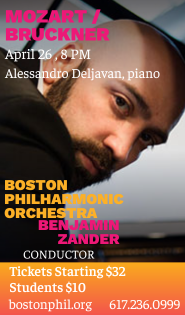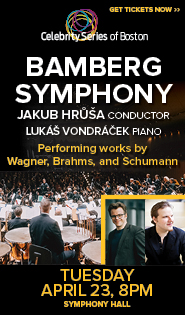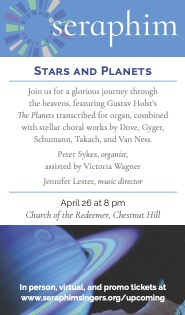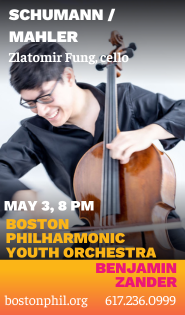Denève, BSO rattle the rafters with Saint-Saëns, American works

Gil Shaham performed John Williams’ Violin Concerto with Stéphane Denève and the BSO Thursday night. Photo: Hilary Scott
Listeners who like their orchestral music big and colorful were in clover Thursday night as French conductor Stéphane Denève led the Boston Symphony Orchestra in two broad-shouldered American pieces and finished up with the splendid racket of Saint-Saëns’s Symphony No. 3, the “Organ Symphony.”
Violinist Gil Shaham demonstrated his own mastery of tone color in a polished if somewhat cool performance of John Williams’s Violin Concerto, composed in 1974-76.
After a few words of welcome and comments on the music from the conductor—hardly necessary, one thought, but maybe some in the audience appreciated the gesture–the program opened in poetic fashion with Jennifer Higdon’s blue cathedral, which the Philadelphia-based composer has described as “a journey through a glass cathedral in the sky.” Although it was Higdon’s Violin Concerto that earned her the Pulitzer Prize, blue cathedral is certainly her runaway hit, having reportedly logged over 600 performances since she composed it in 2000.
On Thursday, it wasn’t hard to see why. The flute-playing composer wrote the piece in memory of her brother, a clarinetist, and solos for both instruments intertwined evocatively (in rich-toned performances by BSO principal Elizabeth Rowe and associate principal Thomas Martin) in an Ivesian polytonal atmosphere with tinkling bells and distant chimes.
As the music swelled, however, one felt transported into the fervent, big-skies sound of mid-century American symphonists like Roy Harris and William Schuman. And the marching-band climax—the composer and her brother both played in one—seemed more cinematic than nostalgic, more chariot race than town square, more Williams than Ives.
After Higdon’s piece closed, touchingly, with the clarinet leaving the flute behind and continuing its journey into the blue (accompanied in this case by a poorly timed attack of audience coughing), it was time for the real John Williams to stand up.
Which he did in his Violin Concerto, channeling not Luke Skywalker as some listeners may have expected, but rather (by his own account) the likes of Bartók, Berg, Walton, and Stravinsky. Hearing this piece, composed in spare moments during work on the scores for The Towering Inferno, Earthquake, and Jaws, one might add Prokofiev, Shostakovich, and even a touch of Khachaturian to that list.
It was, in short, the very model of a mid-20th century violin concerto, gratefully and idiomatically written for the solo instrument, and scored with the hand of a master. Its first movement was songful, plaintive, and playful by turns. The slow movement soared gently at first, then gave way to a fireworks-like episode of twirly falling chromatics and finally a brawny full-orchestra climax. The soloist alternately danced, mused and blazed in the finale, amid bracing orchestral effects.
In the end, however, Williams’s work seemed like highly inventive music that didn’t stray too far from its models, like a violin concerto composed for a movie about a violinist.
Having read in the program notes that the idea to write this piece had come from the composer’s wife, and that she had died unexpectedly that same year, one listened for reverberations of this life-altering event in the music. If they were there, they were buried too deep to hear.
Violinist Shaham may have been partly responsible for this missing emotional link. In many ways, his playing was itself a throwback of half a century, to when the great Russian violinists walked the earth, with their vibrant tone, sovereign technique, sleek phrasing, and breathtaking rubato.
But something seems to happen with every musical style: as the generations come and go, the techniques and the gestures can be passed on, but the essence fades. It seems sometimes that the emotional stab of a Heifetz, the ineffable sweetness of a Milstein, belonged to their age and no other. Perhaps Williams’s concerto needed a dose of that to achieve its full effect.
That said, there are good reasons Shaham is a favorite in these parts, and his poised and accomplished performance Thursday was worth the several minutes of standing applause the audience lavished on it.
He responded with an encore, an ebullient rendition of Percy Grainger’s Molly on the Shore, arranged for unaccompanied violin by Fritz Kreisler.
Conductor Denève led the two American pieces with energy and attention to detail, and the orchestra delivered them in fine form. But the symphony by his countryman Saint-Saëns—dedicated to, and inspired by, the arch-Romantic Franz Liszt—seemed to light a fire under the French maestro, and the result was a compelling rendition of a work that always seems just a performance or two away from being overfamiliar.
The piece’s very opening was something special: a few plaintive wind phrases, from which the symphony’s nervous main theme emerged in violin phrases as soft as a puff of wind. From that insubstantial beginning, the shape-shifting theme would reappear throughout the piece, until it became a triumphant chorale at the end.
But if the theme recalled Schubert’s Unfinished and its development was à la Liszt, Denève never let one lose sight of the Frenchness of this music, its sense of proportion, airy momentum, and suave detailing.
The players were on their mettle, with flashes of virtuosity from the violins here, a trumpet there, and the theme’s constant chatter of staccato sixteenths smartly coordinated within and among the sections. The first movement’s concluding Poco adagio eventually blossomed into a pretty melody in the style of Samson et Dalila, with a bit of “Tchaikovsky lite” surge to it.
The scherzo-finale began with a witty yet vigorous parody of the first movement and built to a bright brassy climax. A gigantic organ chord announced the closing section, rich in unusual timbres such as sparkling piano-and-harp figures, graced with a contrasting theme or two, but mainly occupied with making its chorale theme big and bigger, until all hands were on deck for the audience-delighting, maximum-fortissimo finish.
Organist James David Christie took care of business at the console stage right, laying soft bass notes under the Poco adagio and playing a few choice fortissimo chords in the finale. His good timing with the orchestra was an accomplishment in itself, since an organ “speaks” with a considerable delay from key to pipe.
All in all, though, it was a pretty easy paycheck for the organist, so when the conductor hauled him out from behind the console for a series of solo bows at the end, Christie looked slightly embarrassed at all the attention. Perhaps that, too, is a tradition among organists.
The program, without blue cathedral, will be repeated at a “CasualFriday” concert, 8 p.m. Friday. It will be repeated in full 8 p.m.Saturday. bso.org; 617-266-1200.
Posted in Performances





Posted Mar 20, 2016 at 10:09 am by nimitta
“All in all, though, it was a pretty easy paycheck for the organist, so when the conductor hauled him out from behind the console for a series of solo bows at the end, Christie looked slightly embarrassed at all the attention. Perhaps that, too, is a tradition among organists.”
I thought that, too. But what a superb review of this colorful concert, especially perceptive in regard to the Williams concerto and Gil Shaham’s performance!
Listeners on Saturday night were treated to a different encore, the Gavotte from Bach’s 3rd Partita. This was particularly delightful for those who had the chance to hear Daniil Trifonov encore with Rachmaninoff’s transcription on Wednesday night with the Montreal Symphony Orchestra.